1.3 How Was Abnormality Viewed and Treated in the Past?
In any given year, as many as 30 percent of the adults and 19 percent of the children and adolescents in the United States display serious psychological disturbances and are in need of clinical treatment (Merikangas et al., 2013; Kessler et al., 2012, 2009, 2007, 2005). The rates in other countries are similarly high. Furthermore, most people have difficulty coping at various times and go through periods of extreme tension, dejection, or other forms of psychological discomfort.
It is tempting to conclude that something about the modern world is responsible for these many emotional problems—
Ancient Views and Treatments
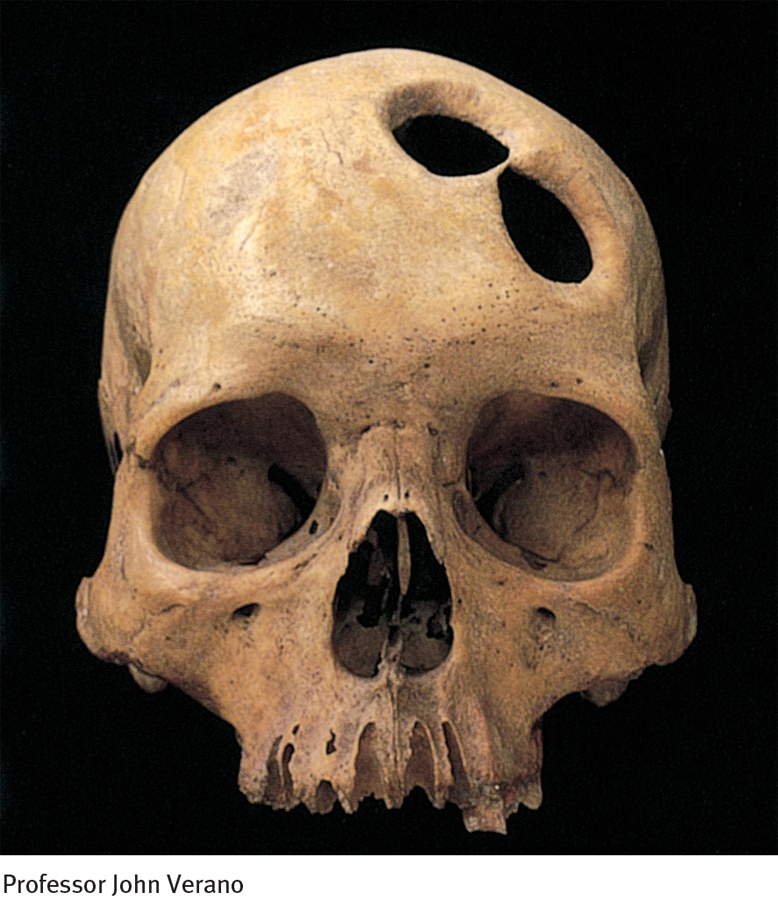
Historians who have examined the unearthed bones, artwork, and other remnants of ancient societies have concluded that these societies probably regarded abnormal behavior as the work of evil spirits. People in prehistoric societies apparently believed that all events around and within them resulted from the actions of magical, sometimes sinister, beings who controlled the world. In particular, they viewed the human body and mind as a battleground between external forces of good and evil. Abnormal behavior was typically interpreted as a victory by evil spirits, and the cure for such behavior was to force the demons from a victim’s body.
This supernatural view of abnormality may have begun as far back as the Stone Age, a half-
 trephination An ancient operation in which a stone instrument was used to cut away a circular section of the skull, perhaps to treat abnormal behavior.
trephination An ancient operation in which a stone instrument was used to cut away a circular section of the skull, perhaps to treat abnormal behavior.
In recent decades, some historians have questioned whether Stone Age people actually believed that evil spirits caused abnormal behavior. Trephination may instead have been used to remove bone splinters or blood clots caused by stone weapons during tribal warfare (Maher & Maher, 2003, 1985). Either way, later societies clearly did attribute abnormal behavior to possession by demons. Egyptian, Chinese, and Hebrew writings all account for psychological deviance this way. The Bible, for example, describes how an evil spirit from the Lord affected King Saul and how David feigned madness to convince his enemies that he was visited by divine forces.
PsychWatch
Modern Pressures, Modern Problems
The twenty-
Terrorism Terror
Global terrorism has become a major source of anxiety in contemporary society, particularly since the September 11, 2001, attacks on the World Trade Center in New York City and the Pentagon in Washington, DC. Moreover, everyday hassles of the past have been turned into potential threats by their association with the actions of terrorists (Aly & Green, 2010; Furedi, 2007). Few people in Kenya, for example, are now able to view shopping as a simple pleasure or minor hassle, given the 2013 militant terrorist attack on the Westgate shopping center in Nairobi, in which at least 67 shoppers were killed.

©Goran Tomasevic/Reuters/Corbis
Crime Phobia
People today are increasingly anxious about crime (Wallace, 2012; Morrall et al., 2010; Scarborough et al., 2010). Some observers note that the fear of crime—
Cyber Fear
Many people live in fear of computer crashes, server overloads, or computer viruses (FBI, 2010). And some, stricken by a combination of crime phobia and cyber fear, worry constantly about e-
What demonological explanations or treatments, besides exorcism, are still around today, and why do they persist?
The treatment for abnormality in these early societies was often exorcism. The idea was to coax the evil spirits to leave or to make the person’s body an uncomfortable place in which to live. A shaman, or priest, might recite prayers, plead with the evil spirits, insult the spirits, perform magic, make loud noises, or have the person drink bitter potions. If these techniques failed, the shaman performed a more extreme form of exorcism, such as whipping or starving the person.
Greek and Roman Views and Treatments
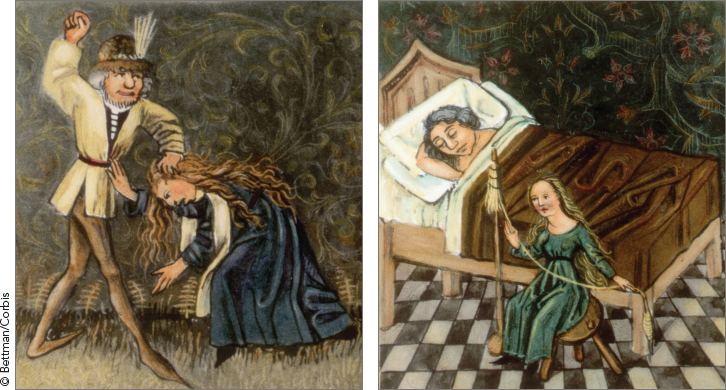
In the years from roughly 500 b.c. to 500 a.d., when the Greek and Roman civilizations thrived, philosophers and physicians often offered different explanations and treatments for abnormal behaviors. Hippocrates (460–
 humors According to the Greeks and Romans, bodily chemicals that influence mental and physical functioning.
humors According to the Greeks and Romans, bodily chemicals that influence mental and physical functioning.
To treat psychological dysfunctioning, Hippocrates sought to correct the underlying physical pathology. He believed, for instance, that the excess of black bile underlying melancholia could be reduced by a quiet life; a diet of vegetables; temperance; exercise; celibacy; and even bleeding. Hippocrates’ focus on internal causes for abnormal behavior was shared by the great Greek philosophers Plato (427–
Europe in the Middle Ages: Demonology Returns
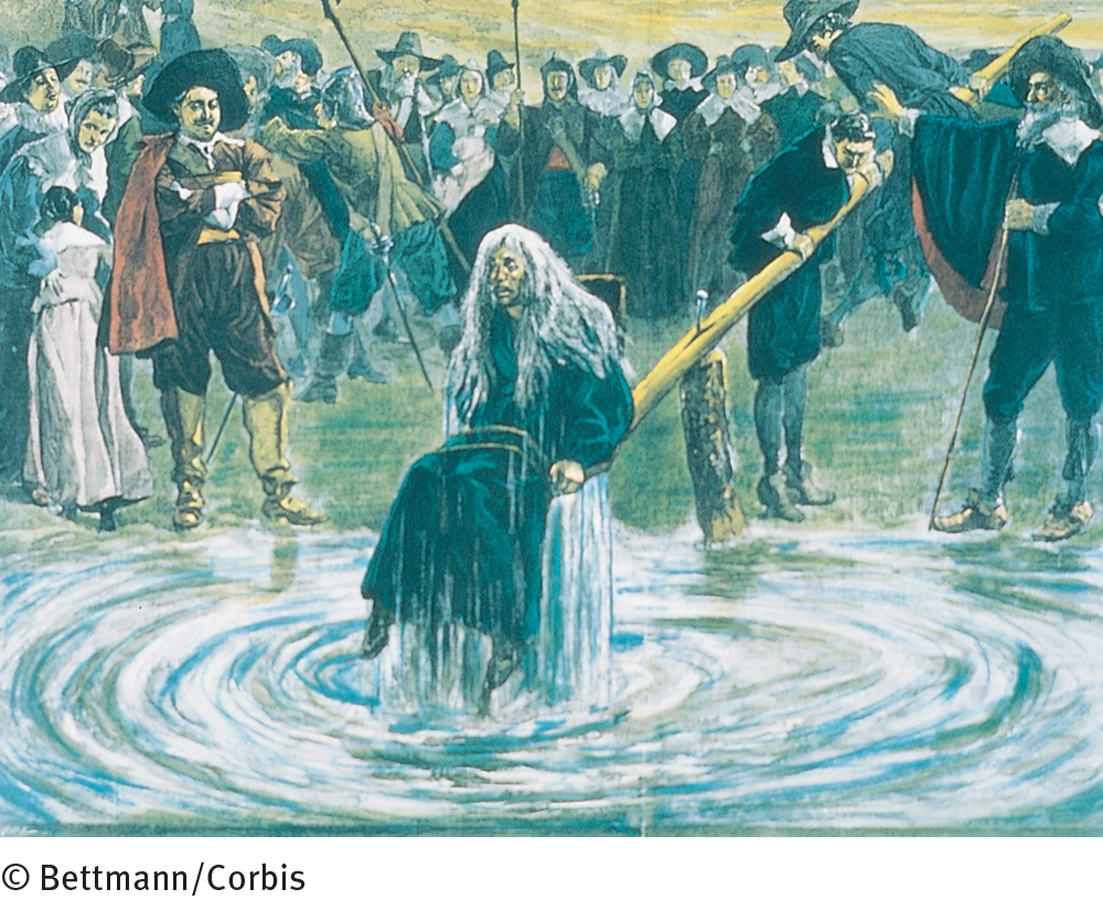
The enlightened views of Greek and Roman physicians and scholars were not enough to shake ordinary people’s belief in demons. And with the decline of Rome, demonological views and practices became popular once again. A growing distrust of science spread throughout Europe.
From 500 to 1350 a.d., the period known as the Middle Ages, the power of the clergy increased greatly throughout Europe. In those days the church rejected scientific forms of investigation, and it controlled all education. Religious beliefs, which were highly superstitious and demonological, came to dominate all aspects of life. Once again behavior was usually interpreted as a conflict between good and evil, God and the devil. Deviant behavior, particularly psychological dysfunctioning, was seen as evidence of Satan’s influence. Although some scientists and physicians still insisted on medical explanations and treatments, their views carried little weight in this atmosphere.
The Middle Ages were a time of great stress and anxiety—
How might Twitter, text messaging, Instagram, Facebook, the Internet, or other technologies facilitate current forms of mass madness?
Not surprisingly, some of the earlier demonological treatments for psychological abnormality reemerged during the Middle Ages. Once again the key to the cure was to rid the person’s body of the devil that possessed it. Exorcisms were revived, and clergymen, who generally were in charge of treatment during this period, would plead, chant, or pray to the devil or evil spirit (Sluhovsky, 2011, 2007). If these techniques did not work, they had others to try, some amounting to torture.
It was not until the Middle Ages drew to a close that demonology and its methods began to lose favor. Towns throughout Europe grew into cities, and government officials gained more power and took over nonreligious activities. Among their other responsibilities, they began to run hospitals and direct the care of people suffering from mental disorders. Medical views of abnormality gained favor once again, and many people with psychological disturbances received treatment in medical hospitals, such as the Trinity Hospital in England (Allderidge, 1979).
The Renaissance and the Rise of Asylums

During the early part of the Renaissance, a period of flourishing cultural and scientific activity from about 1400 to 1700, demonological views of abnormality continued to decline. German physician Johann Weyer (1515–
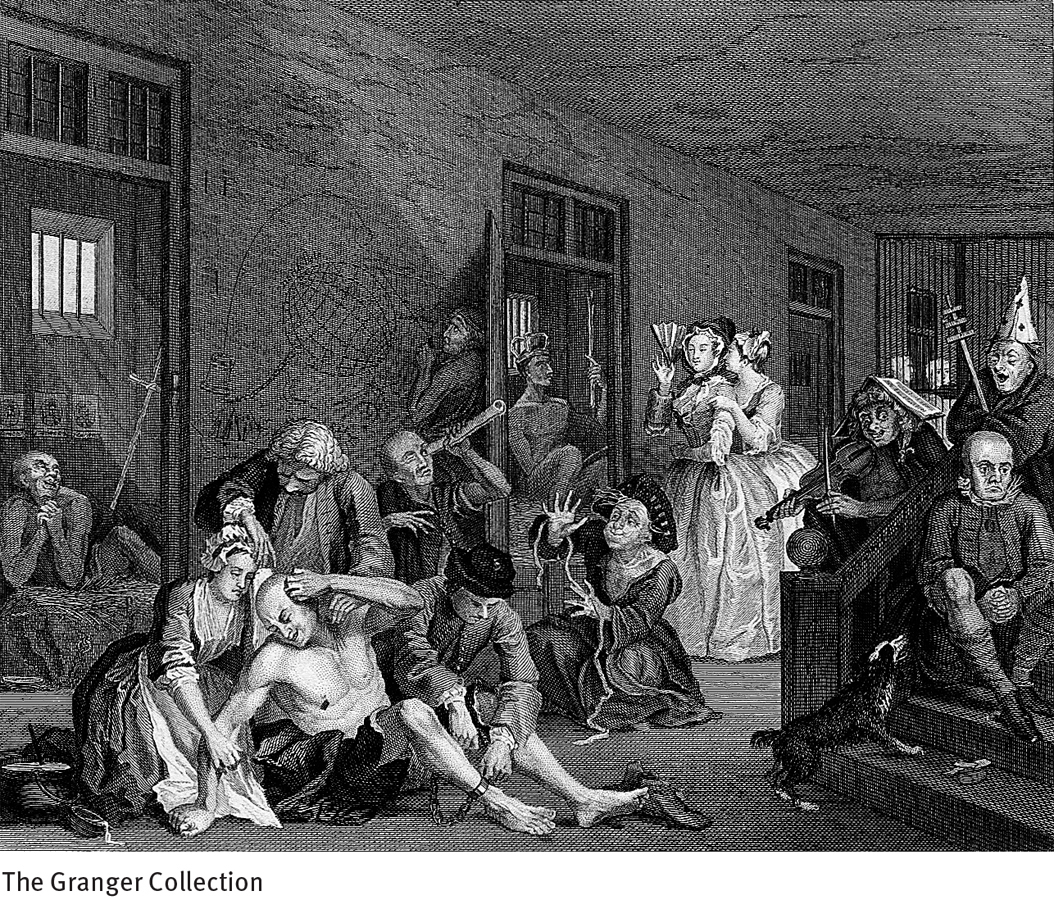
The care of people with mental disorders continued to improve in this atmosphere. In England, such individuals might be kept at home while their families were aided financially by the local parish. Across Europe, religious shrines were devoted to the humane and loving treatment of people with mental disorders. Perhaps the best known of these shrines was at Gheel in Belgium. Beginning in the fifteenth century, people came to Gheel from all over the world for psychic healing. Local residents welcomed these pilgrims into their homes, and many stayed on to form the world’s first “colony” of mental patients. Gheel was the forerunner of today’s community mental health programs, and it continues to demonstrate that people with psychological disorders can respond to loving care and respectful treatment (Guarnieri, 2009; Aring, 1975, 1974). Many patients still live in foster homes there, interacting with other residents, until they recover.
BETWEEN THE LINES
Literature and Abnormal Psychology
Writing during the Renaissance, Shakespeare speculated on the nature and causes of abnormal behavior in 20 of his 38 plays and in many of his sonnets.
(Morris, 2012; Dalby, 1997)
Unfortunately, these improvements in care began to fade by the midsixteenth century. Government officials discovered that private homes and community residences could house only a small percentage of those with severe mental disorders and that medical hospitals were too few and too small. More and more, they converted hospitals and monasteries into asylums, institutions whose primary purpose was to care for people with mental illness. These institutions were begun with the intention that they would provide good care (Kazano, 2012). Once the asylums started to overflow, however, they became virtual prisons where patients were held in filthy conditions and treated with unspeakable cruelty.
 asylum A type of institution that first became popular in the sixteenth century to provide care for persons with mental disorders. Most became virtual prisons.
asylum A type of institution that first became popular in the sixteenth century to provide care for persons with mental disorders. Most became virtual prisons.
In 1547, for example, Bethlehem Hospital was given to the city of London by Henry VIII for the sole purpose of confining the mentally ill. In this asylum, patients bound in chains cried out for all to hear. The hospital even became a popular tourist attraction; people were eager to pay to look at the howling and gibbering inmates. The hospital’s name, pronounced “Bedlam” by the local people, has come to mean a chaotic uproar (Selling, 1940). Such asylums remained a widely used form of “care” until the late 1700s.
The Nineteenth Century: Reform and Moral Treatment
As 1800 approached, the treatment of people with mental disorders began to improve once again (Schuster et al., 2011; Maher & Maher, 2003). Historians usually point to La Bicêtre, an asylum in Paris for male patients, as the first site of asylum reform. In 1793, during the French Revolution, Philippe Pinel (1745–
Meanwhile, an English Quaker named William Tuke (1732–
The Spread of Moral TreatmentThe methods of Pinel and Tuke, called moral treatment because they emphasized moral guidance and humane and respectful techniques, caught on throughout Europe and the United States. Patients with psychological problems were increasingly perceived as potentially productive human beings whose mental functioning had broken down under stress. They were considered deserving of individual care, including discussions of their problems, useful activities, work, companionship, and quiet.
 moral treatment A nineteenth-
moral treatment A nineteenth-
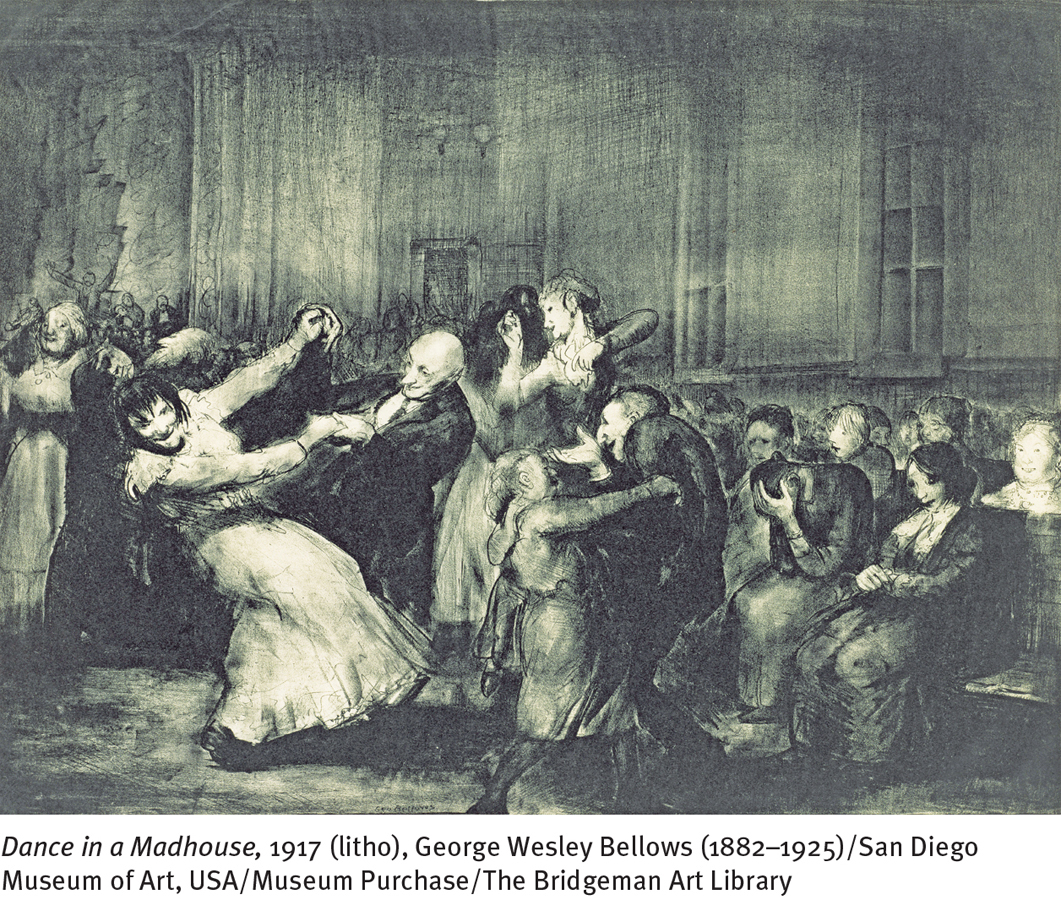
The person most responsible for the early spread of moral treatment in the United States was Benjamin Rush (1745-
Rush’s work was influential, but it was a Boston schoolteacher named Dorothea Dix (1802–
 state hospitals State-
state hospitals State-
The Decline of Moral TreatmentBy the 1850s, a number of mental hospitals throughout Europe and America reported success using moral approaches. By the end of that century, however, several factors led to a reversal of the moral treatment movement (Kazano, 2012; Cautin, 2011; Bockoven, 1963). One factor was the speed with which the movement had spread. As mental hospitals multiplied, severe money and staffing shortages developed, recovery rates declined, and overcrowding in the hospitals became a major problem. Another factor was the assumption behind moral treatment that all patients could be cured if treated with humanity and dignity. For some, this was indeed sufficient. Others, however, needed more effective treatments than any that had yet been developed. An additional factor contributing to the decline of moral treatment was the emergence of a new wave of prejudice against people with mental disorders. As more and more patients disappeared into large, distant mental hospitals, the public came to view them as strange and dangerous. In turn, people were less open-
By the early years of the twentieth century, the moral treatment movement had ground to a halt in both the United States and Europe. Public mental hospitals were providing only custodial care and ineffective medical treatments and were becoming more overcrowded every year. Long-
MediaSpeak
Immigration and the Mentally Ill in the 21st Century
By Andrew Solomon, The New York Times, December 8, 2013
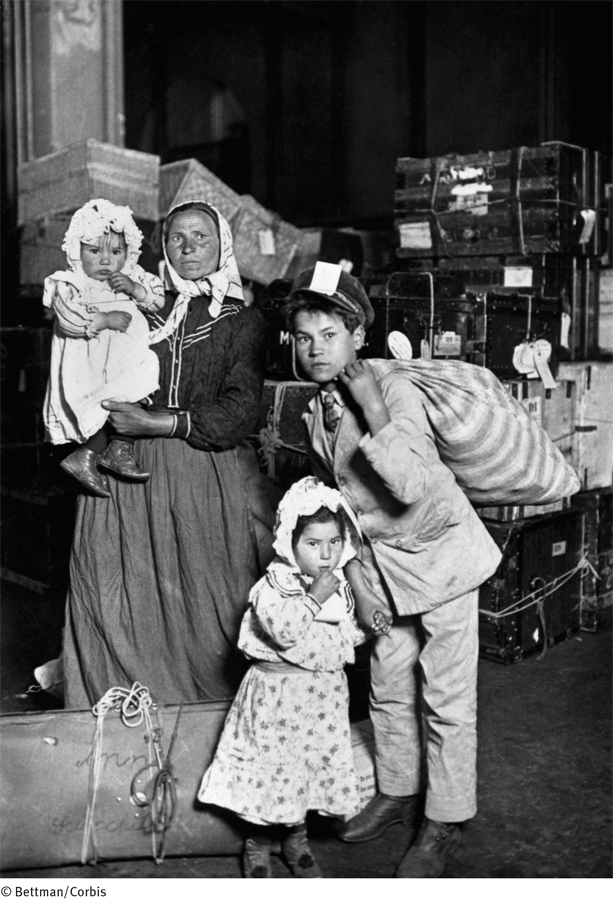
A Canadian woman was denied entry to the United States last month because she had been hospitalized for depression in 2012. Ellen Richardson could not visit, she was told, unless she obtained “medical clearance” from one of three Toronto doctors approved by the Department of Homeland Security. Endorsement by her own psychiatrist, which she could presumably have obtained more efficiently, “would not suffice.” She had been en route to New York, where she had intended to board a cruise to the Caribbean….
The border agent told her he was acting in accordance with the United States Immigration and Nationality Act, Section 212, which allows patrols to block people from visiting the United States if they have a physical or mental disorder that threatens anyone’s “property, safety or welfare.” The [Toronto] Star reported that the agent produced a signed document stating that Ms. Richardson would need a medical evaluation because of her “mental illness episode.” …
This is not the first time such measures have been reported. In 2011, Lois Kamenitz, a Canadian and a former teacher, was barred from entering the United States because she had once attempted suicide. Ryan Fritsch, former co-
Ms. Richardson’s health information should never have been available to United States authorities, and many Canadians are outraged at the thought that their government may have divulged it…. Much more troubling, however, is the notion that information about a person’s depression, no matter how legitimately obtained, might have any bearing on her ability to visit the United States.
What kind of roles should mental health experts play in the development of immigration, gun, or other laws that target people with mental disorders?
People in treatment for mental illnesses do not have a higher rate of violence than people without mental illnesses. Furthermore, depression affects one in 10 American adults…. Pillorying depression is regressive, a swoop back into a period when any sign of mental illness was the basis for social exclusion…. [T]his border policy is not only unfair to visitors, but also constitutes an affront to the millions of Americans who are grappling with mental-
Stigmatizing the condition is bad; stigmatizing the treatment is even worse…. Yet this incident will serve only to warn people against seeking treatment for mental illness…. Ms. Richardson, who attempted suicide in 2001 and as a result is paraplegic, has asserted that she has had appropriate treatment, and that she now has a fulfilling, purposeful life. We should applaud people who get treatment and manage to live deeply despite their challenges…. The president needs to speak out against Section 212 … and to put to rest the idea that people with mental health conditions who pose no danger are unwelcome in our country.
December 8, 2013, “Opinion: Shameful Profiling of the Mentally Ill” by Andrew Solomon. From The New York Times, 12/8/2013, © 2013 The New York Times. All rights reserved. Used by permission and protected by the copyright laws of the United States. The printing, copying, redistribution, or retransmission of this content without express written permission is prohibited.
The Early Twentieth Century: The Somatogenic and Psychogenic Perspectives
As the moral movement was declining in the late 1800s, two opposing perspectives emerged and began to compete for the attention of clinicians: the somatogenic perspective, the view that abnormal psychological functioning has physical causes, and the psychogenic perspective, the view that the chief causes of abnormal functioning are psychological. These perspectives came into full bloom during the twentieth century.
 somatogenic perspective The view that abnormal psychological functioning has physical causes.
somatogenic perspective The view that abnormal psychological functioning has physical causes.
 psychogenic perspective The view that the chief causes of abnormal functioning are psychological.
psychogenic perspective The view that the chief causes of abnormal functioning are psychological.
The Somatogenic PerspectiveThe somatogenic perspective has at least a 2,400-
Two factors were responsible for this rebirth. One was the work of a distinguished German researcher, Emil Kraepelin (1856-
New biological discoveries also triggered the rise of the somatogenic perspective. One of the most important discoveries was that an organic disease, syphilis, led to general paresis, an irreversible disorder with both physical and mental symptoms, including paralysis and delusions of grandeur (Hogebrug et al., 2013; Kaplan, 2010). In 1897, the German neurologist Richard von Krafft-

The work of Kraepelin and the new understanding of general paresis led many researchers and practitioners to suspect that physical factors were responsible for many mental disorders, perhaps all of them. These theories and the possibility of quick and effective medical solutions for mental disorders were especially welcomed by those who worked in mental hospitals, where patient populations were now growing at an alarming rate.
Despite the general optimism, biological approaches yielded mostly disappointing results throughout the first half of the twentieth century. Although many medical treatments were developed for patients in mental hospitals during that time, most of the techniques failed to work. Physicians tried tooth extraction, tonsillectomy, hydrotherapy (alternating hot and cold baths), and lobotomy, a surgical cutting of certain nerve fibers in the brain. Even worse, biological views and claims led, in some circles, to proposals for immoral solutions such as eugenic sterilization, the elimination (through medical or other means) of individuals’ ability to reproduce (see Table 1-1 below). Not until the 1950s, when a number of effective medications were finally discovered, did the somatogenic perspective truly begin to pay off for patients.
|
Year |
Event |
|---|---|
|
1896 |
Connecticut became the first state in the United States to prohibit persons with mental disorders from marrying. |
|
1896–1933 |
Every state in the United States passed a law prohibiting marriage by persons with mental disorders. |
|
1907 |
Indiana became the first state to pass a bill calling for people with mental disorders, as well as criminals and other “defectives,” to undergo sterilization. |
|
1927 |
The U.S. Supreme Court ruled that eugenic sterilization was constitutional. |
|
1907–1945 |
Approximately 45,000 Americans were sterilized under eugenic sterilization laws; 21,000 of them were patients in state mental hospitals. |
|
1929–1932 |
Denmark, Norway, Sweden, Finland, and Iceland passed eugenic sterilization laws. |
|
1933 |
Germany passed a eugenic sterilization law, under which 375,000 people were sterilized by 1940. |
|
1940 |
Nazi Germany began to use “proper gases” to kill people with mental disorders; 70,000 or more people were killed in less than 2 years. |
|
Information from: Fischer, 2012; Whitaker, 2002. |
|
BETWEEN THE LINES
Lunar Myths
Although it is popularly believed that a full moon is regularly accompanied by significant increases in crime, strange and abnormal behaviors, and admissions to mental hospitals, decades of research have failed to support this notion.
(Bakalar, 2013; 2011; Schafer et al., 2010; McLay et al., 2006)
The Psychogenic PerspectiveThe late nineteenth century also saw the emergence of the psychogenic perspective, the view that the chief causes of abnormal functioning are often psychological. This view, too, had a long history, but it did not gain much of a following until studies of hypnotism demonstrated its potential.
Hypnotism is a procedure in which a person is placed in a trancelike mental state during which he or she becomes extremely suggestible. It was used to help treat psychological disorders as far back as 1778, when an Austrian physician named Friedrich Anton Mesmer (1734–
It was not until years after Mesmer died that many researchers had the courage to investigate his procedure, later called hypnotism (from hypnos, the Greek word for “sleep”), and its effects on hysterical disorders. The experiments of two physicians practicing in the city of Nancy in France, Hippolyte-
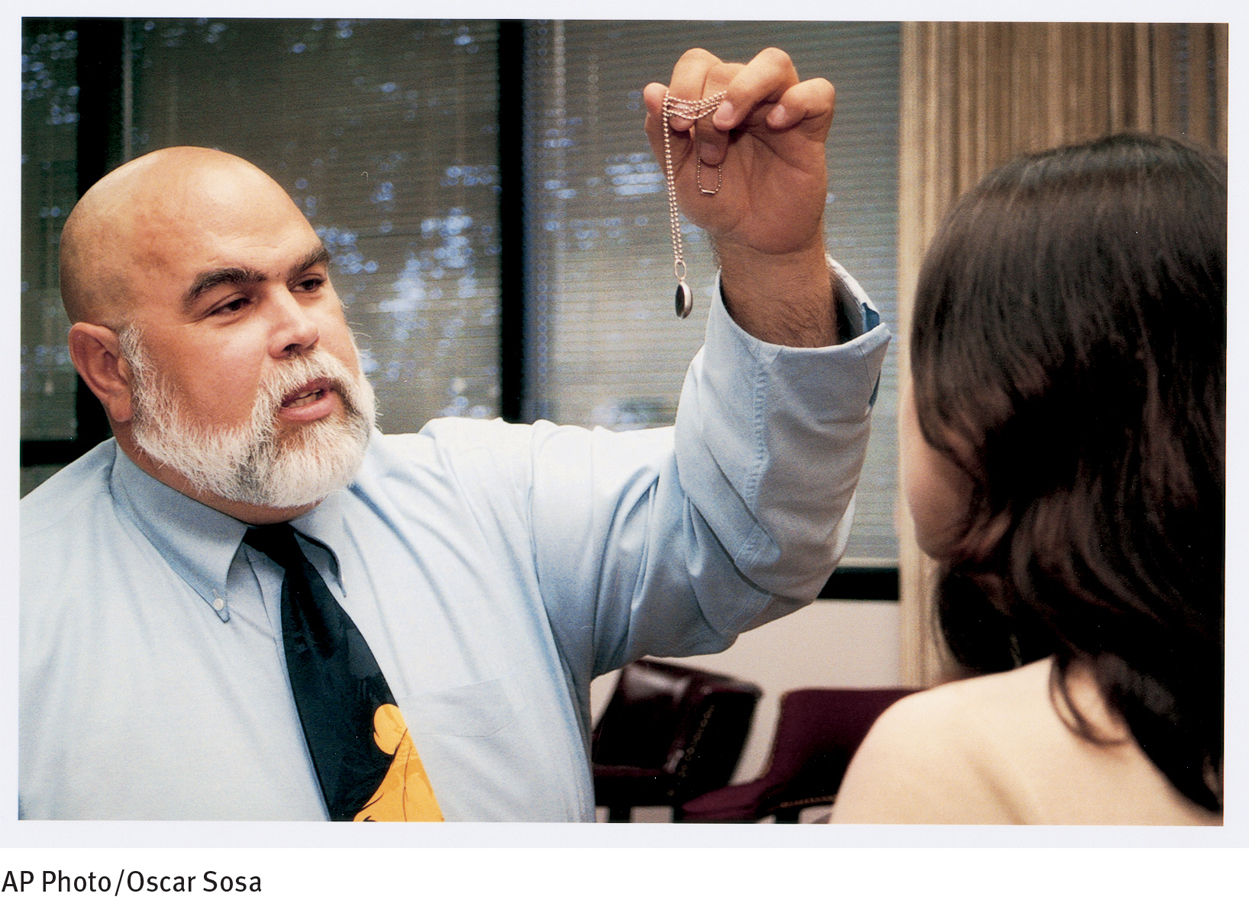
Among those who studied the effects of hypnotism on hysterical disorders was Josef Breuer (1842–
 psychoanalysis Either the theory or the treatment of abnormal mental functioning that emphasizes unconscious psychological forces as the cause of psychopathology.
psychoanalysis Either the theory or the treatment of abnormal mental functioning that emphasizes unconscious psychological forces as the cause of psychopathology.
Freud also developed the technique of psychoanalysis, a form of discussion in which clinicians help troubled people gain insight into their unconscious psychological processes. He believed that such insight, even without hypnotic procedures, would help the patients overcome their psychological problems.
Freud and his followers offered psychoanalytic treatment primarily to patients suffering from anxiety or depression, problems that did not typically require hospitalization. These patients visited therapists in their offices for sessions of approximately an hour and then went about their daily activities—